GCSE results day 2022: Results at a glance

GCSE results were released this morning in England, revealing an expected fall in the proportion of top grades and a slight decrease in the overall pass rate for all entries.
This year, students completed the first summer exams series after two years of cancellations owing to Covid-related disruption.
Exams were cancelled in 2021 for the second consecutive year and students were awarded teacher-assessed grades, leading to grade inflation.
Find out about GCSE results day 2023
But this year, exams returned with mitigations put in place to help students who had their learning disrupted by the pandemic, including advance information topics and exam aids such as formulae and equation sheets.
Here are the headlines figures for today’s GCSE results.
Grades fall but remain far above 2019 levels
The proportion of entries graded 7/A or above was 26 per cent overall. This is a marginal decrease of 2.5 percentage points on the 2021 figure but well above the 20.6 per cent of entries that received the grade or above in 2019.
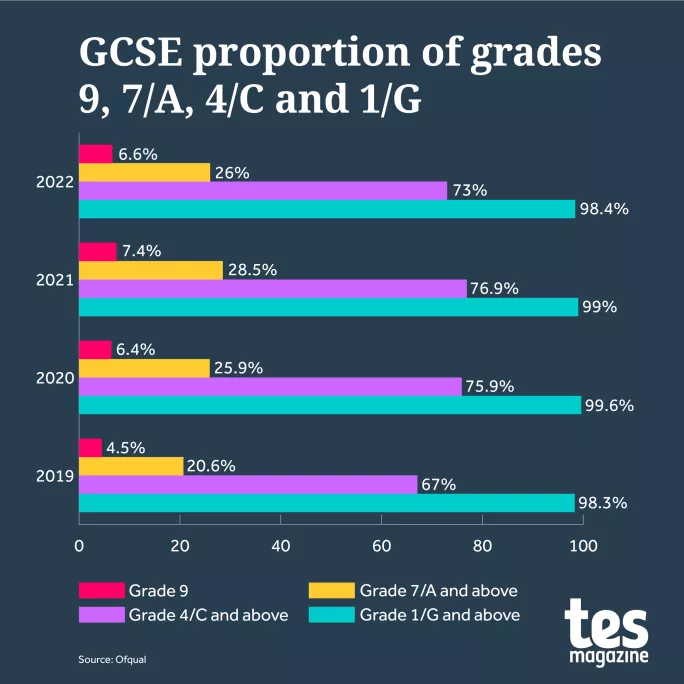
The proportion of students receiving a grade 9/A* was 6.6 per cent this year, down from 7.4 per cent in 2021 but up from 4.5 per cent in 2019.
At grade 4/C, there was a fall of 3.9 percentage points on last year, with 73 per cent of entries awarded this grade or above compared with 76.9 per cent in 2021 and 67 per cent in 2019.
And at grades 1/G and above, the overall rate is 98.4 per cent, a fall from 99 per cent last year, but a slight rise from 98.3 per cent in 2019.
Results by gender
Girls continued to outperform boys at GCSE this year.
The gender gap at grade 7/A and above has narrowed slightly by 1.4 percentage points on 2021. In total, 30.7 per cent of entries from girls were awarded the top three grades compared with 23.3 per cent of entries from boys, making the gender gap 7.4 percentage points.

The gender gap has also decreased slightly at grade 4/C and above, with 71.9 per cent of entries from boys and 78.7 per cent of entries from girls achieving a GCSE pass, a gap of 6.8 percentage points compared with 7 percentage points last year.
GCSE English results
In English language, 20.2 per cent of entries scored a grade 7/A or above compared with 22 per cent in 2021 and 13.9 per cent in 2019.
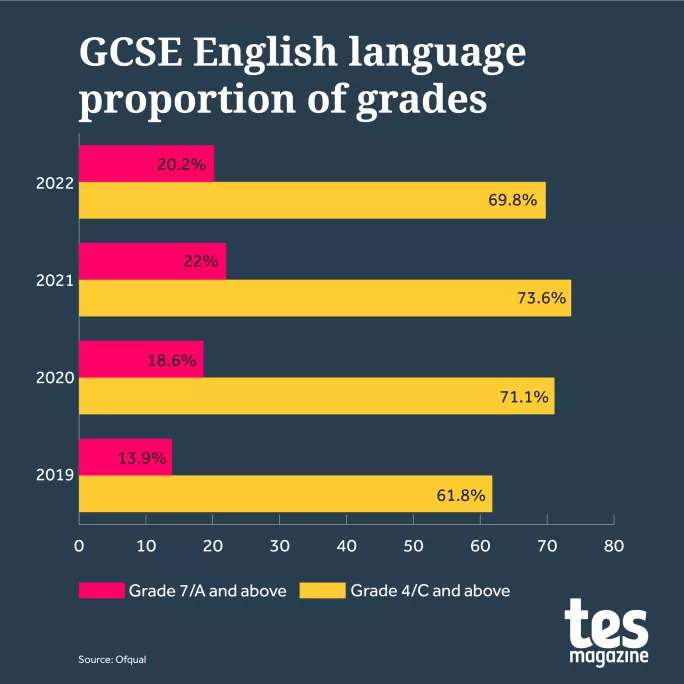
The pass rate at 4/C also fell, to 69.8 per cent - but that is still up from 61.8 per cent in 2019.
In English literature, 23.8 per cent of entries achieved grade 7/A or above and just over three-quarters (77.5 per cent) passed. This is down from last year, when 25.7 per cent of students received a grade 7/A or above in English literature and 80.3 per cent achieved a grade 4/C or above.
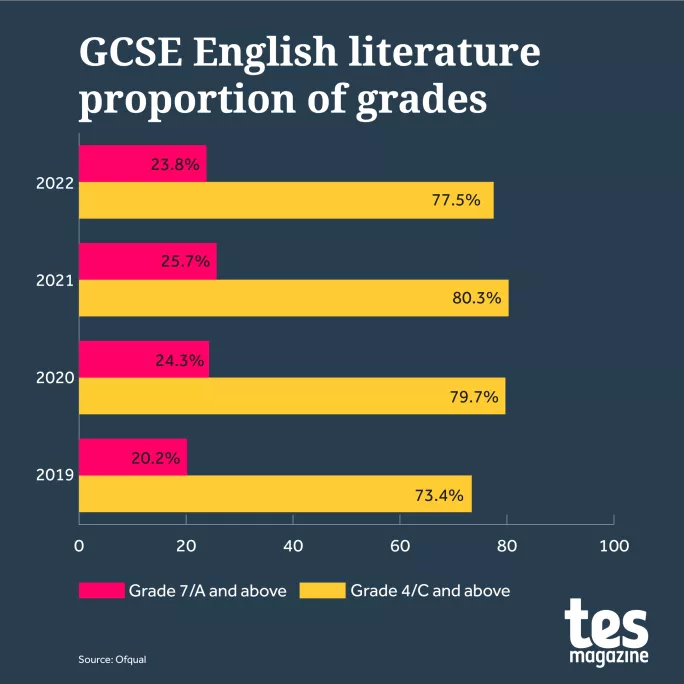
GCSE maths results
In maths, there was a decrease in the proportion of students achieving a grade 7/A or above: 19.9 per cent, compared with 20.6 per cent last year and 15.9 per cent in 2019.

And 64.9 per cent of entries secured a pass, compared with 69.2 per cent in 2021 and 59.6 per cent in 2019.
GCSE history and geography results
In history, 29.5 per cent of entries scored the top three grades compared with 32.3 per cent in 2021 and 24.6 in 2019.

There was a decrease in pass rates, with 70.7 per cent of entries achieving a 4/C grade or above compared with 76.2 per cent last year and 63.6 per cent in 2019.
Provisional entries in history were slightly down from 278,880 in 2021 to 278,750 this year.
In geography, 30.3 per cent achieved a grade 7/A or above and 72.1 per cent achieved a pass, compared with 34.3 per cent and 76.8 per cent respectively in 2021.
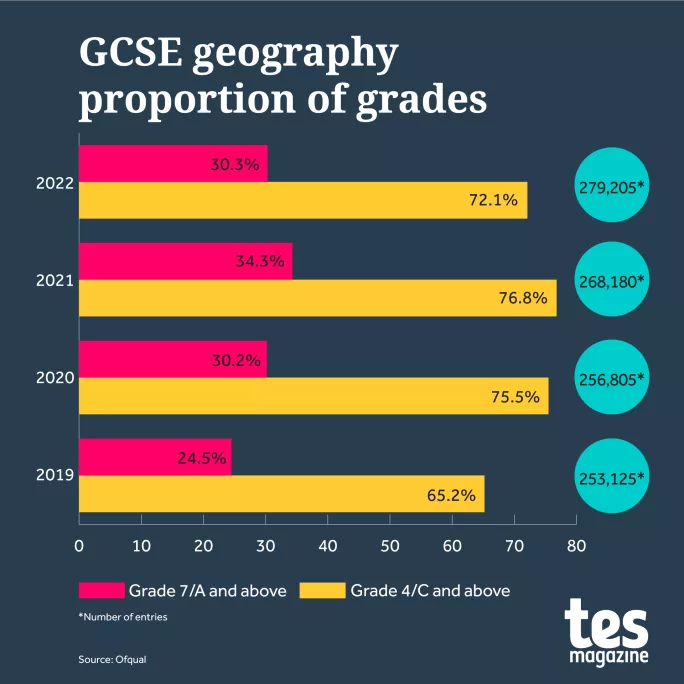
Provisional entries in geography were up by 4.1 per cent this year to 279,205.
GCSE German, Spanish and French results
Students achieving a grade 7/A or above in German was down on last year to 35.1 per cent, compared with 38 per cent last year and 24.2 per cent in 2019.
The percentage of students passing their German GCSE was 83.5 per cent, down on 87.6 per cent in 2021 and up on 75.8 per cent in 2019.
German provisional entries saw a 2.8 per cent decrease in 2022 to 36,000, with 37,035 entries last year.
French continues to be the most popular modern language subject at GCSE, with 126,185 provisional entries this year, but it saw a fall in the top grades: 31.4 per cent achieved a grade 7/A or above compared with 32.9 per cent in 2021 and 23.7 per cent in 2019.
The pass rate fell by 5 percentage points to 78.1 per cent compared with 83.1 per cent last year and 69.7 per cent in 2019.
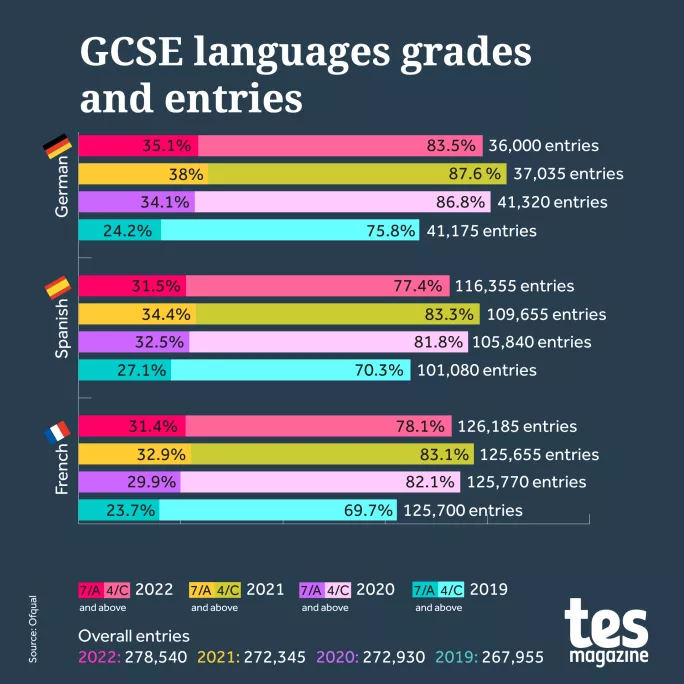
And in Spanish, 31.5 per cent of entries achieved the top three grades compared with 34.4 per cent in 2021 and 27.1 per cent in 2019.
77.4 per cent achieved a pass this year compared with 83.3 per cent last year and 70.3 per cent in 2019.
Entry levels for all three modern foreign languages saw an increase of 2.3 per cent on 2021 figures, rising to 278,540.
The results for GCSE French and German will reflect the adjustments that exam boards were required to make, as an ambition to better align the grade standards with Spanish.
But while provisional entries were up this year, the final number of students to sit the exam fell across all three subjects.
In German, the final number of students sitting the exam was 34,966 this year, down from 36,933 last year and a massive 18 per cent decrease from the 2018 figures.
While French continued to be the most popular language, the number of students sitting the exam fell from 124,739 in 2021 to 122,746 this summer.
And in Spanish, the figures also fell from 108,982 in 2021 to 107,488 in 2022.
Overall, the number of students sitting a modern foreign language in 2022 fell by 2 per cent year on year, from 270,654 to 265,200.
GCSE sciences: biology, chemistry and physics results
In the three sciences, top grades fell across the board but were still far above 2019 levels.
In biology, 49.8 per cent of entries secured grade 7/A or above compared with 55.8 per cent last year and 42.3 per cent in 2019.

Meanwhile, the pass rate fell by 2.2 percentage points to 91.9 per cent, up from 89.6 per cent in 2019.
In chemistry, the proportion of top grades fell by 5 percentage points to 49.6 per cent and the pass rate fell by 1.5 percentage points to 92.8 per cent.
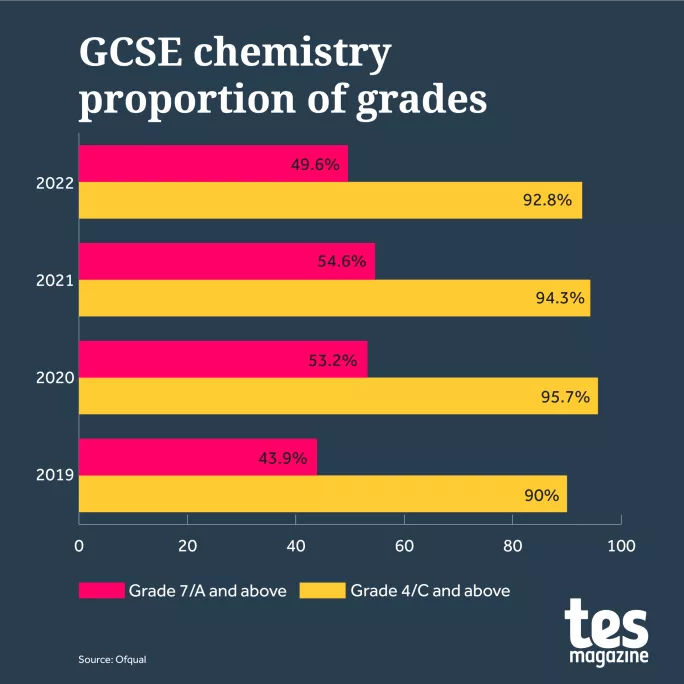
The number of students achieving a grade 7/A or above in 2019 was 43.9 per cent.
And in physics, 7/A grades fell by 5 percentage points to 50.3 per cent, while the pass rate fell by 1.6 percentage points to 93.7 per cent.

For double award entries, 10.3 per cent of entries secured the top three grades compared with 12.2 per cent last year, and the pass rate fell by 4.2 percentage points to 60.5 per cent.
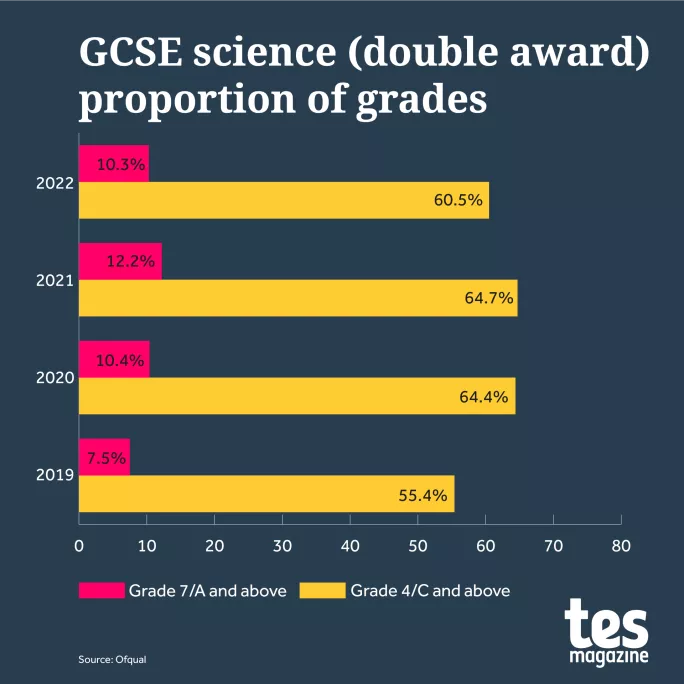
GCSE art, music, drama and design and technology results
Arts subjects experienced a fall in their overall pass rates compared with last year’s results, but rates remained higher than in 2019.
In art and design, 28.1 per cent secured a grade 7/A or higher compared with 30.2 per cent in 2021 and 22.7 per cent in 2019.

The pass rate in art and design was 81.4 per cent this year, compared with 84.8 per cent in 2021 and 75.1 per cent in 2019.
In music, 44.1 per cent secured one of the top three grades compared with 50.2 per cent last year and 31.8 per cent in 2019.
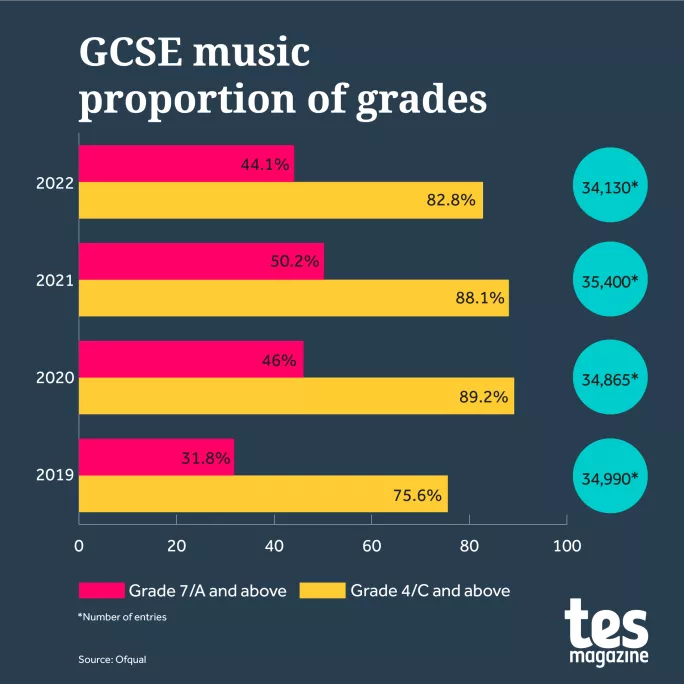
In drama, 34 per cent of entries secured a grade 7/A or higher compared with 40.6 per cent last year.

The pass rate in drama was 80.8 per cent this year, a fall from 85.2 per cent in 2021 and up from 74.2 per cent in 2019.
And in design and technology, 26.8 per cent secured the top three grades, a fall of 3.3 percentage points on 2021. The pass rate was 71.5 per cent.
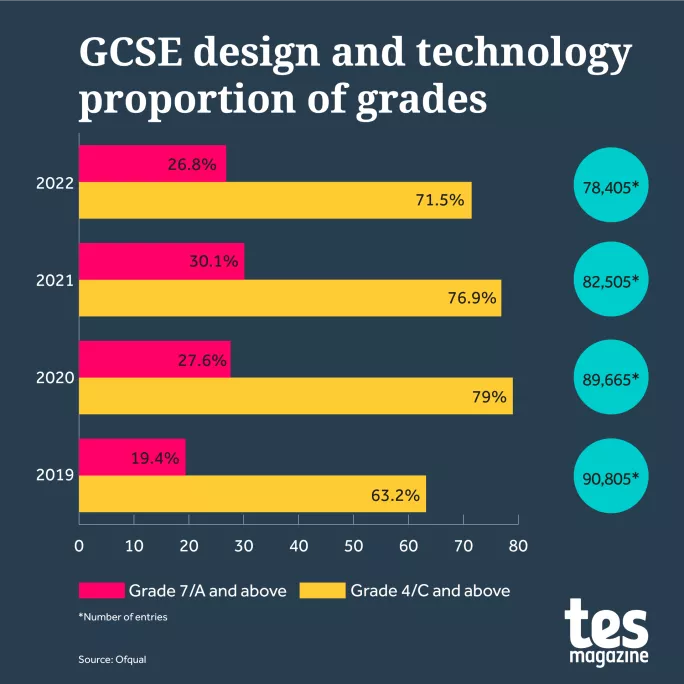
GCSE computing results
The proportion of students achieving the top three grades in computing fell to 34 per cent from 39.4 per cent in 2021 but was still far above the 2019 figure of 21.6 per cent figure.

And the number achieving a grade 4/C or above was 75.2 per cent this year, down from 82.4 per cent in 2021 and up from 62.6 per cent in 2019.
Provisional entries were up on last year at 79,135, an increase of 2.4 per cent on 2021 numbers.
GCSE physical education results
The percentage of students achieving a grade 7/A or above this year was 34.1, down from 40.5 per cent in 2021 but far above the 2019 figure of 21.1 per cent.

And the number passing their PE GCSE was 81.9 per cent, down from 87 per cent in 2021 but up from 71.8 per cent in 2019.
You need a Tes subscription to read this article
Subscribe now to read this article and get other subscriber-only content:
- Unlimited access to all Tes magazine content
- Exclusive subscriber-only stories
- Award-winning email newsletters
Already a subscriber? Log in
You need a subscription to read this article
Subscribe now to read this article and get other subscriber-only content, including:
- Unlimited access to all Tes magazine content
- Exclusive subscriber-only stories
- Award-winning email newsletters
topics in this article



